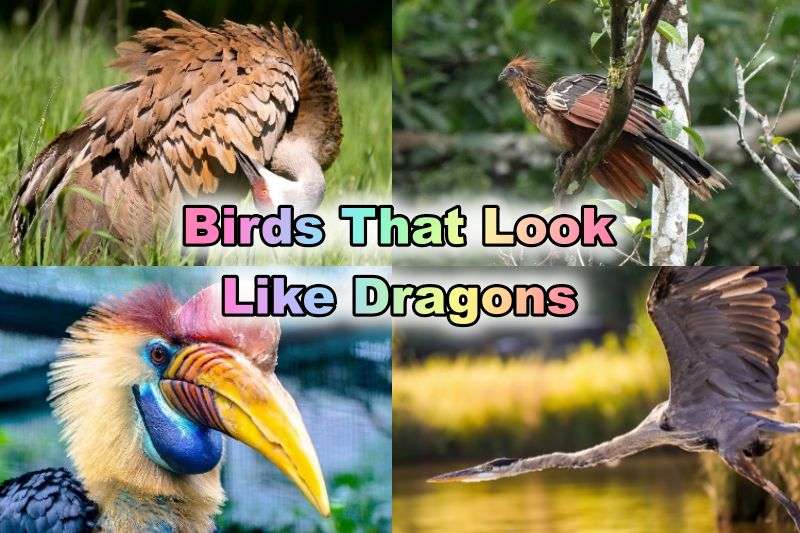It’s always been hard to classify a mythological creature, as they have characteristics from different groups; dragons are no exception. Dragons share features with reptiles, mammals, and birds. Dragons are similar to birds in having feathered wings and colorful plumage. Some birds look terrific, with huge bills, striking eyes, and a fearsome build, and give off the vibe of a dragon. This article contains a list of 15 Birds That Look Like Dragons. If you have a fantastical dream of owning your own pet dragon, you can domesticate an exotic dragon bird.
15 Types of Birds That Look Like Dragons
1) Great Hornbill
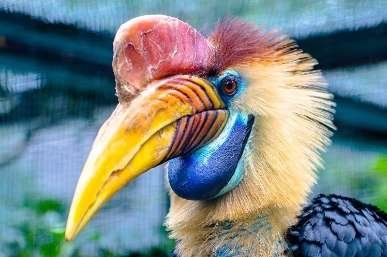
First on the list is a furiously looking great hornbill, with its sharp, curved bill and an outstretched casque atop it. The bill is whitish-yellow with hues of red on the edge.
They are enormous birds weighing 3 kg with a wingspan of up to 178 cm. They have sharp wingtips, just like a dragon. These birds are primarily black, with white on their bellies and tails.
They also have a yellow neck with a tinge of orange. They have strong neck muscles and fused vertebrae to support the bill. The massive bill aids in fighting, preening, catching prey, and building nests.
- Scientific Name: Buceros bicornis
- Size: 95–130 cm (37–51 in).
- Location: the Indian subcontinent and Southeast Asia.
2) Shoebill
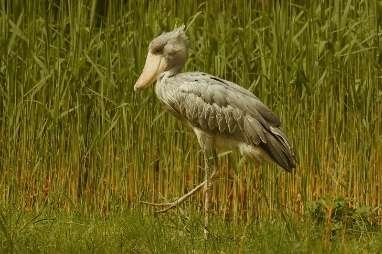
Second on the list is the shoebill, a stork with deadly claptrap and petrifying plumage. The shoebills are long, sturdy birds with a distinctive buff-colored, shoe-shaped bill that has a very sharp hook at the end. They have a large skull to support their massive bill and a fairly short neck to assist the bill.
They have gray-blue plumage with darker greyish flight feathers and a somewhat navy blue tail. These birds grab rather sizable prey, including crocodiles and big antelopes.
Their ferocious look, bold attacks, and striking features are no less than those of dragons. They have a prehistoric-like appearance and are also known as “whale-headed storks.”
- Scientific Name: Balaeniceps rex
- Size: 100–140 cm (39–55 in).
- Location: East Africa
3) Vulturine Guineafowl
The vulturine guineafowl was so named because of its long, bare, featherless neck and head. They are also called “royal guineafowl” because of their conspicuous appearance.
These are round-shaped birds with rather slim necks protruding from lustrous blue and white hackles. They have a matte blue head and a metallic blue breasts and back.
The rest of the bodies’ plumage is black with white spots and streaks on the feathers. These are flightless birds, but they are great runners. These birds are very aggressive and are known to fiercely attack their counterparts.
- Scientific Name: Acryllium vulturinum
- Size: 61–71 cm (24–28 in)
- Location: Northeast Africa
4) The Great Eared Nightjar
The large ear tufts and mottled buff plumage on its head distinguish the great-eared nightjar. The upper parts are golden-brown with black speckles. It has a broad tawny-buff nape and dark brown wing covers.
The broad tail has beautiful beige, black, and brown alternating patterns with orange freckles all over its plumage and tail. When these birds open their pink napes and look boldly into their big black eyes, they look just as terrific as dragons.
With these features, it looks like a plump, mystical, fluffy dragon hatchling. These are nocturnal birds and are mostly active at dusk and dawn.
- Scientific Name: Lyncornis macrotis
- Size: 31–41 cm (12–16 in).
- Location: South Asia and Southeast Asia
5) Bearded Vulture
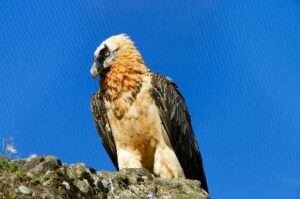
The Bearded Vulture is an extremely large vulture with a plumed body and a diamond-shaped tail. This vulture does not have a bald head, and it’s quite feathered, unlike other vultures. These birds have small, heavy heads and strong, muscular necks.
It appears bulkier due to the plumed hunchback of these birds. Naturally, these vultures are cream-colored with black plumage and a white face, but they modify their appearance by rubbing their necks and heads in iron-rich soil and turning reddish-orange from white.
They do so to show off and intimidate their predators. These birds have red eyes, which they illuminate out of curiosity.
They are known to be “bone eaters,” and more than 70 percent of their diet consists of pure bones. Though these birds look as deadly as dragons, they never kill.
- Scientific Name: Gypaetus barbatus
- Size: 94–125 cm (37–49 in).
- Location: southern Europe, East Africa, the Indian subcontinent, Tibet, and the Caucasus.
6) Cassowary
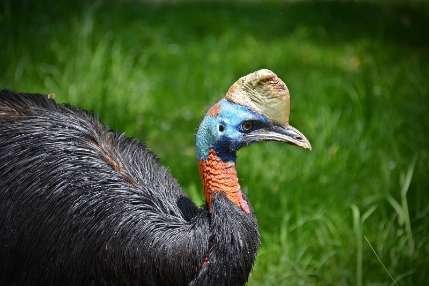
Again, we have a prominent-looking, flightless bird that is the world’s second-heaviest bird and weighs over a hundred pounds. This bird is capable of killing humans using its massive, giant leg as a weapon.
When viewed from a distance, the cassowary’s plumage is shiny, dense, and black in color, resembling hairs. Their distinguishing elongated, brown-black, helmeted casque serves as protection.
They have a purplish-blue head and a brightly colored blue, orange, and red neck. A red-colored, fleshy caruncle can be seen drooping from its neck. These vivid colors and giant appearance make them look like dragons.
- Scientific Name: Casuarius casuarius
- Size: 1.5–1.8 m (4.11–5.11 ft).
- Location: north-east Queensland, Papua New Guinea, and surrounding islands.
7) Emu
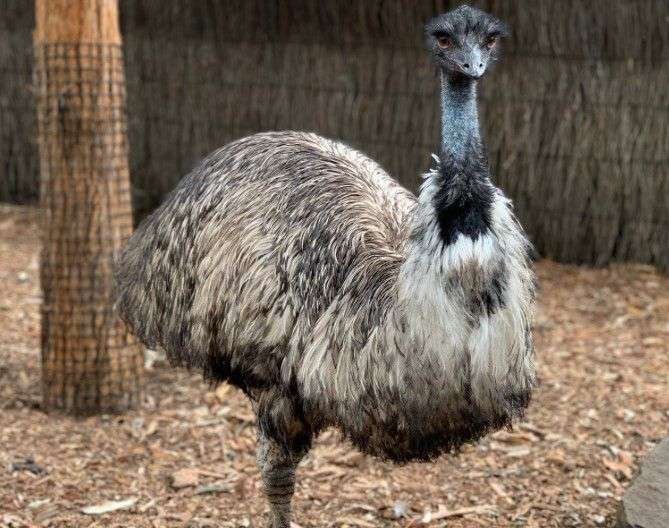
Emus are plump-bodied, long-legged, flightless birds. Emus have three toes on each foot, which assist them in the running at a speed of 50 km per hour.
Some remarkable features they share with dragons are that, although they are flightless, they have vestigial wings; both wings have a small claw at the tip; and they flap their wings when running, perhaps as a means of stabilizing themselves while moving fast.
The neck of the emu is long and cobalt blue in color, which is evident through its sparse feathers. They have rusty-brown plumage and a hairy appearance. The shafts and the edges of the feathers are black. Emus’ appearance can vary from a rufous tint to darker hues.
These birds are known to gulp large pebbles to grind their food and enhance digestion.
- Scientific Name: Dromaius novaehollandiae
- Size: 1.9 meters (6.2 ft).
- Location: Australia
8) Hoatzin
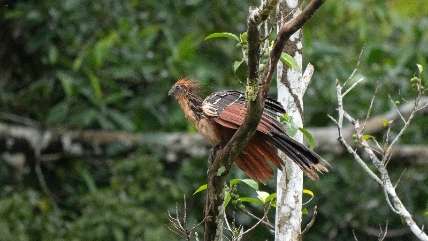
Hoatzins have striking features that resemble those of a dragon. It has a small, blue face and bears a spiky, erected rufus crest of orange color on top of its head.
This feature causes some people to refer to it as the “punk rock bird.” It has a blue face with amber eyes. The underparts of the neck and breast are buff or orange, while the belly and under tail coverts are darker brown.
The wings are dark brown, gray, or black, except for the outer feathers, which are rusty red. The flanks are of “reddish-chestnut” color, and the wingtips are vibrant yellow.
They have long, dagger-like tails to counterbalance their crop and scramble along branches. Hoatzins are really strange birds with a chicken-like look and cow-like stomach; it’s also known as the “Flying Cow.”
- Scientific Name: Opisthocomus hoazin
- Size: 65 cm (26 in).
- Location: South America, principally in the Amazon
9) Great Blue Heron
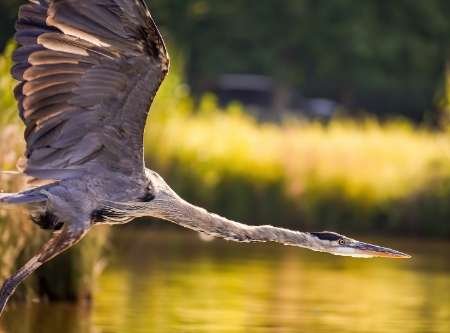
When seen from different angles, the great blue heron surely looks like a storybook creature, and when they are fluffing up for a flight, they do have the “dragon ready for flight” look.
It is the largest of the North American herons, with extensive legs, an “S”-shaped neck, and a stout, dagger-like bill. They have sharp, keen hackles and slaty (grayish-blue) plumage.
These birds look shaggy with all those beautiful feathers. The neck is rusty-gray with white and black streaks down the throat. They have a sharp white face, and a pair of black plumes run from just above the eye line to the back of the head.
The upper parts of the wing look two-toned, with blue-grey on the forewing and navy blue on the flight feathers. The color of the plumage varies in different species; for example, the great white heron has purely white plumage.
The great blue herons have specialized feathers, called “powder down,” that continuously grow and fray into a powder, and this powder is later used to help clean off fish slime.
- Scientific Name: Ardea herodias
- Size: 91–137 cm (36–54 in).
- Location: North and Central America
10) Sandhill Crane
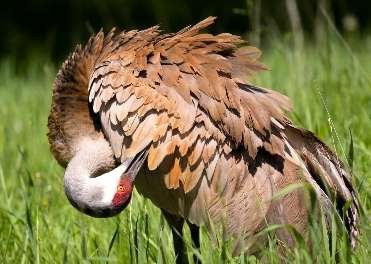
Sandhill cranes have a bright red crown and a needle-like bill that is larger than their heads. When in flight, they stretch their necks and legs, and with those broad and chiseled wings, they give off dragon vibes. These are very tall, sturdy birds with long necks, extensive legs, and expansive wings.
They have a bulky body, and their short tail is covered by falling feathers that form a “bustle” around their back. Their base color is slate gray, with a blueish or brownish rust wash on the lower neck, back, and upper parts. They have brown-black wingtips and solid black legs.
Sandhill cranes are known to paint themselves muddy before breeding season to fuse in with the brown vegetation of an estuary.
- Scientific Name: Antigone canadensis
- Size: 80–136 cm (2.7–4.6 ft).
- Location: North America and north-eastern Siberia.
11) Plate-Billed Mountain Toucan
The plate-billed mountain toucan is a beautifully colored bird with a rainbow-colored bill and eye rings. They have dark heads with big black eyes. Their bills are elongated and indigo and maroon, with a lighter patch and pointed nails.
These birds are blue with bronzy-olive upper parts with a greenish tinge and pale yellow flanks and rump. They have bright red under tail coverts, and the tail is purplish blue with chestnut tips.
Their colorful pattern and fluffy plumage on the legs give them the appearance of a dragon.
However, these species are rapidly declining because of their short range and habitat loss, and we need to protect them if we want to admire their beauty.
- Scientific Name: Andigena laminirostris
- Size: 42-53 cm (16.5-21 inches)
- Location: the west slope of Ecuador and extreme southern Columbia
12) Cinereous Vulture
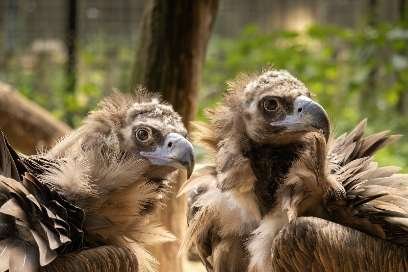
The Cinereous Vulture is one of the heaviest birds, with a weight of 14 kg and a wingspan of almost 10 ft. These vultures look majestic with their heavy, broad bodies and a fuzzy ruff that looks like the collar of a winter coat.
These birds are also known as black vultures because of their solid black or brown, dense plumage. They have broad, brown wings and a diamond-shaped tails. Some specimens have a cream-white ruff and a crisp white neck, whereas others have a paler head and neck.
They have pale blue faces with a raptorial bill that is so powerful that it can tear open the toughest hides and even the bones. These killer birds are known to attack and kill live prey.
- Scientific Name: Aegypius monachus
- Size: 1.2 m (3 ft 11 in)
- Location: Southern and eastern Europe, the Middle East, and Central Asia
13) Helmeted Hornbill
The helmeted hornbill has a huge, elongated, keratinized, helmet-like casque and bizarre facial features; they also have extremely long tails, even for hornbills! It has a tough and sturdy bill with red and yellow coloration.
They have dark, mostly blackish plumage on the wings and most of the body, but there is a featherless, wrinkled patch of leathery skin on the neck, which is red in males and pale blue to green in females. They have two extremely long central tail feathers that are white with black stripes.
These birds’ casque, unlike other hornbills, is quite solid, and the skull with casque and bill may constitute 10 percent of the bird’s weight.
- Scientific Name: Rhinoplax vigil
- Size: 110–120 cm (43–47 in)
- Location: the islands of Borneo and Sumatra, and the Malay Peninsula in southern Thailand.
14) American White Pelican
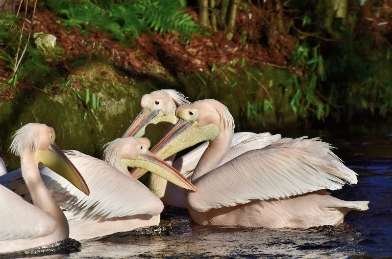
The Great White Pelican is also known as the rosy pelican because of its pinkish plumage and huge yellow, rosy pink, or light blue bill.
They have a distinctively stocky build and enormous bills, used for creating a large pouch to catch aquatic animals, primarily fishes.
When the pelican puts down its bill underwater, the lower bill expands, creating a large pouch to carry water and fish; after that, it lifts its head, contracting the pouch, thereby forcing out the water but retaining the fish.
These pelicans are known for the huge amounts of fish they consume, often feeding as much as four pounds a day. Though they have short legs, they propel their feet in the water and make a rather awkward takeoff, but it is an elegant soaring birds during flight and can fly splendidly at higher altitudes.
- Scientific Name: Pelecanus onocrotalus
- Size: 140 to 180 cm (55 to 71 in).
- Location: Southeastern Europe, Asia, and Africa
15) American Bald Eagle
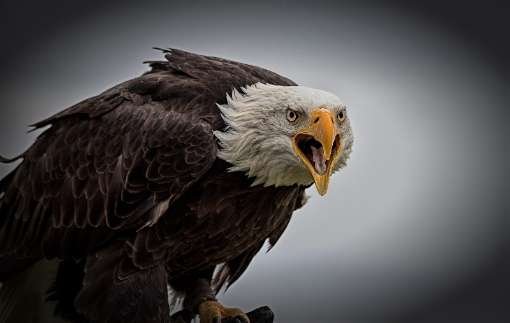
The bald eagle is considered to be a true raptor and is called “bald” because of its iconic white head. It has powerful wings with dark brown plumage and a wingspan of up to 7 feet, giving it the appearance of a dragon.
These birds have a distinctive, large yellow bill that is larger than their head. They have powerful yellow feet and steady, large talons. These highly developed talons are useful in piercing the hidden parts of the prey.
These birds are attackers and are known to attack humans. During the breeding season, they become defensive and defend their territory, so it’s nice to maintain a good distance from them.
They have huge eyes that almost cram their skull and amazing eyesight that can even spot a small rabbit from three miles away!
- Scientific Name: Haliaeetus leucocephalus
- Size: 2.5–3 ft.
- Location: Canada and Alaska
Conclusion:
Do dragons exist? We don’t know the answer to this question but what we surely know is there are some ravishing birds that look like dragons and share appearances with them. Some birds also have deadly features that resemble dragons and are magical, just like them. Here, we conclude our article.
Reference: Wikipedia, All about birds, Britannica.
Also Read:

Hey there! I’ve been the kid who used to love watching all the science stuff and that fascination lead me to choose Zoology as my Major in Graduation. I’m a self-taught writer and spend my time writing scintillating content on animals. I love observing animals behavior and their bond with humans. I want to give my point of view regarding animals i research about. I had done several projects on animals during my graduation and learned their behavior thoroughly.
